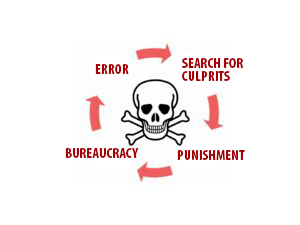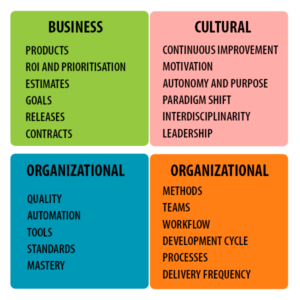Imagine a person living a sedentary life, with an unhealthy diet, fighting mirror & wardrobe for some time. They’ve decided to turn their life around and live healthily. All motivated, they sign up for the gym, buy some gym clothes and tennis just like Usain Bolt’s or Elaine Thompson’s.
The next day, that motivation’s gone. Now… Have they become any healthier? This is a fake transformation (or, in case, illusory agility). It looks like you achieved something, but nothing happened. We’ve achieved nothing because, in fact, we’ve changed nothing inside.
Water-Scrum-fall is a kind of fake transformation. I’ve heard it for the first time from Jez Humble (author of Continuous Delivery) at GOTO 2015. According to him, many companies end up adopting Scrum just for part of the value chain but keep to traditional methods for everything else. What they get is a sandwich, slightly better than 100% top to bottom, but still leveraging like a mere 10% of the capabilities of agile methods.
Water-Scrum-fall at work
An example is when the development team receives the product scope conceived by some stakeholder “of great intelligence” who-knows-exactly-what-the-consumer-needs-and-foresees-all-that’ll-change-in-the-market-up-to-the-final-deadline… already closed. Check out Fixed Scope: The Illusion. And this is the first step of the cascade.
Notice that when it happens, we lose the main advantage of agile methods: the ability to adapt to changes coming from clients, businesses, or the market.
Since the team has the scope “fully” thought out from the beginning, it uses Scrum or another agile method to develop the product in short cycles and periodically presents it to the stakeholders. That was the agile chapter of this story since this team cannot put anything in the hands of the end consumer.
For the product to get to the client, now we need to seek permission. Some are essential, such as environmental permits and regulatory agencies’ licenses, but most of the time, that’s not the case.
Bureaucracy is often a control-minded answer to some past failures. Instead of looking for the root cause and solving it systemically, we look for culprits, punish them. “To launch this product in this market we need the green light from this mythical Director X… who didn’t even know that product was in development in the first place.” Yay.
Change leads to problem. Problem leads to fear. Fear leads to Bureaucracy! And Bureaucracy… is the path to paralysis.
If you’ve been in your business for a while, you know things don’t always go as beautifully as graduations, MBAs, and technical courses say they do. By now, you’ve probably learned something at the School of Hard Knox, and maybe even been hunted down in a quest for culprits. We’ve all gone through that and obviously got worried about our professional and personal future.
With such baggage, to survive in the market, our tendency may become “sharing” our responsibilities. The problem, of course, is that this defense mechanism is also present in the minds of many you work with.

We begin to exhibit total aversion to risk, even in thought. All errors must be predicted and averted at any cost. We end up with processes packed full of fluxes, descriptions, and authorizations, which become so complex and extensive they just won’t fit in a single sheet of paper. Ever.
However, errors are quite like a cold. When you least expect it… Atchoo! And 38.5ºC fever. Instead of having a true continuous improvement process, we fall into a vicious cycle of continuous deterioration: error, search for culprits, punishment, bureaucracy.

Bureaucracy: to infinity and beyond!
I’ll leave the corporate setting for a moment and give you a personal example. I profess a faith that has the main canon. In principle, everybody should follow such cannon, and nothing outside of it should interfere in the followers’ lives. But… This hasn’t prevented many from coming up with their own “rules”: clothes to wear or not, make-up and personal accessories to avoid or not, television shows to watch or not, songs to hear or not, and so on.
Somebody has an idea and creates a rule, then someone else comes along, has an idea, and creates yet another new rule. With time there are so many rules that it makes it almost impossible for someone to follow this faith without breaking some non-canon rule. Guilt, abandon, and rebellion end up being common in religious groups that fall for that.
Companies often behave similarly. We create complex processes that become so slow that nothing seems to ever get to the client’s hands. When we finally deliver it, that necessity has already been addressed by ten different start-ups, and we’ve just lost tons of market share.
Furthermore, since we’ve had to rush stuff at the end, our product gets to the consumer still full of problems. Social media replace the old Customer Services like Facebook, Twitter, and Instagram, and these have no mercy. They’re outside the company’s control, and complaints become public. I recommend the documentary Fyre Festival to grasp the power social media has today.
The more we fail, the more we create processes to avoid failure, and the more complexity we build into the system, the more we fail.

War room
When complexity grows, and deadlines shrink, comes the time of rebellion. Let’s form a War Room, a Crisis Room. Now we can create a multidisciplinary team and throw complexity out the window because “shit just got real”. Bureaucracy is gone, but the pressure is enormous. War Rooms are known for their 18-hour shifts, people freaking out, lost weekends, résumés updated, etc.
It poses the question: why the hell are we on the limit in the first place? Why, when we can have truly multidisciplinary teams from the beginning and processes that were once important can readily be discarded?

“Bye, bye illusory agility”
Always think of Agile Transformation as something that must happen in the Four Domains of Agility.

Organizational
Yes! To have an agile transformation, it’s crucial that we have changed within the organization. New roles will be created, and some will be extinguished. We must strive to have the most multidisciplinary team possible with every necessary expertise to participate from inception to delivery to the end consumer and tracking of results. This might be a significant break away from the usual feudal specialist hierarchy we have in so many companies.
We must also review the workflow and all processes. At this stage, it’s common for people to think, “Well, I’ve got all these processes here. Now let’s see which of those fit this team that’s now multidisciplinary.” Since we have a huge bureaucracy, we don’t really want to review all those processes, do we? I like to start from the opposite question. Now that we have a multidisciplinary team, which are the essential processes for it to work? Adding is easier than removing.
More processes mean more complexity. I like to use a board on a wall to show the whole flux of value from the formulation of ideas to tracking results. The more steps you add, the bigger it gets, and as this impacts people’s work, they begin to question the system’s complexity.

Furthermore, keep your efficiency metrics up to date to know the impact of bureaucracy in your system.
However, pay close attention to organizational changes. Don’t expect it to happen overnight. That may create a breaking point that might block any transformation. If the company is not in any dire situation, prefer a more evolutionary approach. In the end, we want constant “War Room,” but without all the pressure, to begin projects with all the necessary expertise and minimum bureaucracy.
Before adding a new process, stop and consider “Can we automate this?” Is this a lack of expertise or a lack of autonomy? What should we do to gain the trust of the person who’s asking for a new process?
Business
Without involvement, transparency, and participation of business people, all change will be based on feeling, which is unsustainable in the long run. Business people and product development people must work TOGETHER in the same team. At first, everybody knows what is valuable to the consumer, and then so that all involved may seek this value.
In addition to working together, having efficiency metrics is mandatory. How many clients did we acquire with this last delivery? What’s our average ticket? What’s our client’s satisfaction level? How are our competitors doing? It’s imperative that the team understands the business problem it’s trying to solve and the context from which such a problem arose. With this, they can contribute directly to new and better ideas, without intermediate filters.
Cultural
Calling the IT Department a Squad and expecting it to turn itself into a team is as effective as calling someone Monica Bellucci and expecting their looks to improve drastically, or calling your friend Tiger Woods and expecting them to win golf tournaments.
Culture is crucial in any transformation. In the case of agile transformation, it’s the first step. We want multidisciplinary, self-organized, self-managed teams that continuously improve themselves and the organization as a whole.
This isn’t something you can just snap your fingers and get done. We have to support them in this transformation and think strategically, always. I like to tease coaches and Scrum Masters by asking, “What mistakes did we make and what did we learn?” “What is the most important move I can make today that’ll help my team/company to achieve better results (in efficacy and efficiency)?” “How do I advertise actions that had positive results?”
Those first questions relate to actions towards cultural change in a strategic way. The last one reflects something my ex-manager Sonia Moreira says: a chicken that didn’t cackle has laid no egg.
Technical
Instead of creating complex layers of “error avoidance”, how about automating this and that work? Once in a coaching session, Rodrigo de Toledo said, “Before bringing one more person into this process, make it an automated step.” You bring someone into the loop after you’ve tried to automate a sizeable portion of it. It prevents errors in many root causes and makes deliveries more agile.
It’s also important that quality is never “delaygated” to someone else or some other team. Ensuring product quality is the duty of every team member. No exceptions.
Conclusion
Escape from fake agility. If it’s transformation we want, then let’s bring transformation. No half-measures. Staying on the fence for too long is tiresome, painful, and unsustainable. Change the culture and track the actual evolution of the company closely with metrics.
Check out some personal recommendations from our blog content and training courses.
What do you want to know more about?
Necessary culture for an agile transformation
Training: Certified Scrum Master (CSM); Management 3.0;
Articles: Continuous improvement: Today’s Pain Is Tomorrow’s Success; Humans, not Resources;
How to deal with processes in an agile way
Training: Certified Scrum Master (CSM); Kanban System Design (KMP I);
Articles: What is STATIK? Powerful tips on how to apply the Kanban method!; Silos: visualizing and dealing with the team’s dependencies;
Bringing business people in and how they should deal with products
Training: Certified Scrum Product Owner (CSPO)
Articles: Discovering the role of the Product Owner; Metrics: a powerful way of measure Agility within organizations and teams; 6 tips for defining successful metrics for your product; Toxic metrics: what can kill Agility in your team?
Do you have a truly agile culture in your company, or are you living an illusion of agility? Discover how to avoid this trap!
